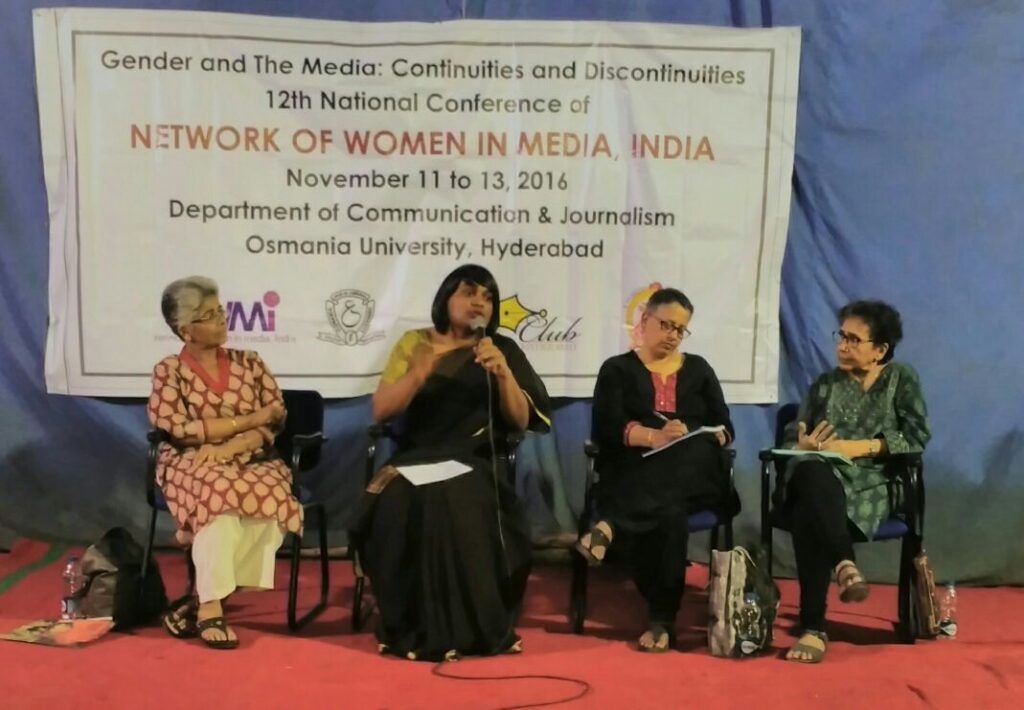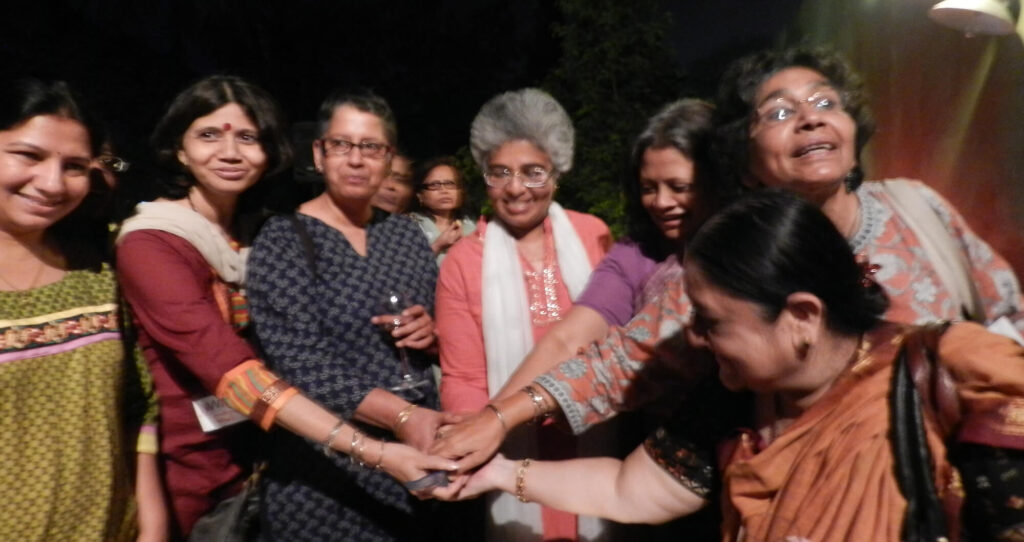The bearable lightness of being – the NWMI 14 years later, at the Hyderabad meet
It is wonderful to be back in Hyderabad for the 12th national meeting of the Network of Women in Media, India. It has been over 11 years since the last national meeting held here – in 2005. That was the third national meeting, after the first one in Delhi in 2002 – at which the network was born – and the second one in Mumbai in 2004.
Several of us here today also remember the three regional meetings that preceded the first national one: in Bangalore in the first year of the millennium (2000), in Jaipur in early 2001 and in Shillong later in 2001. Participants from Bihar who had attended the Jaipur meeting went back and organised a meeting in Patna a few months later, which saw the participation of a large number of women journalists from across the state. So, in a way, the network began its journey 16 years ago – to the month (the regional meeting in Bangalore, the first in the series, took place in November 2000, if I remember correctly).

But the genesis of the network goes back even further. When I was interviewing women journalists across the country towards the end of the 1990s, many of them spoke about the need for a separate forum or platform for women in the profession. Quite a few said they were not satisfied with existing unions, for one reason or another. Of course, several of them had tried to create women’s cells within unions and a few of these were functioning quite well. But there was still, clearly, a yearning for another, different space, the form, shape and elements of which could be determined by women.
Even back then there were fledgling attempts by media women in several cities to create such spaces – in Hyderabad and Ahmedabad, for example. And those initiatives in the 1990s were reminiscent of groups that existed in Delhi, Mumbai, Bangalore and possibly elsewhere in the 1980s. So the impulse among women in the media to come together as professionals with shared interests and concerns has existed for decades.
As I wrote in the chapter titled, “Nurturing Networks,” in the book based on the interviews mentioned earlier (plus as much background research as was possible in those days), there was little doubt in the late 1990s that “many women across the country would welcome a professional association in which they could play an active part.”
It is in response to that felt need that the network came to be.

Information about the history and evolution of the NWMI are available on our website (in the About Us section). The souvenir being released here today also includes an article providing some details of the story so far. So I won’t take up time reiterating all that now. Instead I will just share a few thoughts on the network as a whole and what I think makes it special, at least to us.
When I was thinking about the task assigned to me by the organisers of this three-day meeting, trying to figure out how to introduce the network, what came to my mind was a song from the ever-green musical, The Sound of Music:
“How do you solve a problem like Maria?
How do you catch a cloud and pin it down?
How do you find a word that means Maria?
A flibbertigibbet! A will-o’-the wisp! A clown!”
It seems to me that the NWMI is a lot like Maria.
It is in many ways a cloud, especially now that the word is often used as a metaphor for the Internet. Much of the time it is a virtual network, with our interactions taking place in our Yahoo, Facebook and WhatsApp groups. That’s why these periodic national meetings are so precious, giving us an opportunity to cross the physical distance between us, meet face to face, and continue our online conversations in real time and space.
How important this is to many of us is evident from the fact that we not only take time off from our busy schedules and free ourselves of professional and personal preoccupations to travel cross-country, paying our own way, contributing a modest registration fee, for the pleasure of spending time with each other, sharing experiences and views, learning from each other and invited speakers, and participating in actual debates (not what news television channels call debates).
I must mention here that a few of us have pressing and unavoidable commitments elsewhere this weekend but have actually come all the way to Hyderabad – in one case only for a day – just to join the network gang, even if for the briefest encounter. If that isn’t testimony to the appeal of the network, I don’t know what is.
As you know, the word cloud is also used to refer to a state or cause of gloom, suspicion, trouble, or worry. That meaning fits us, too. We do worry a lot and share our troubled thoughts, suspicions and general gloom about the state of the country and the world – especially but not only in relation to the media and the status of women – in our various groups, real and virtual.
Over the past few days, for example, our online conversations have ranged from the recent bans on TV news channels and the humiliation of an LGBTQ couple by a Telugu TV show host to the resignation of a certain news anchor and the untimely death of another one, from the false murder charges slapped by the Chhattisgarh police on university professors and others to the death of a transgender person found burnt outside a police station, from the government-induced currency crisis to the catastrophe of the US elections, and much else. We hope to continue most of them this weekend, in conference sessions and outside.
I should add a few words here about our national meetings. Held in different parts of the country – Delhi, Mumbai, Hyderabad, Kolkata, Bangalore, Pune, Imphal, Kozhikode and Ahmedabad – they have been organised by volunteer members of local networks, who somehow make the time and summon up the energy and enthusiasm to do so in the midst of their own professional work and other preoccupations. The programmes evolve through consultation and consensus, with network members from elsewhere also contributing ideas but leaving it to the local hosts to make the final decisions about the schedule, topics, speakers and other activities.
Since the network has no funding per se, a major task that local organisers take on is seeking support in cash or kind for the specific purpose of the meeting. I must say that institutions in Hyderabad – media organisations in the past and universities this time around – have been particularly supportive, and I would like to take this opportunity to appreciate the relationships our members here evidently have with these institutions and, of course, the generosity of our local sponsors.
Now, moving on, to the other words in the song about Maria, and by extension the NWMI. A flibbertigibbet is, apparently, “a frivolous, flighty, or excessively talkative person.” Now does that apply to us? What do you say? Frivolous? Sometimes. Flighty? Occasionally. Excessively talkative? Certainly! So, all in all, yes, I think we can plead guilty to being flibbertigibbets when we take some time off from being worrywarts.
From flibbertigibbet to clown is not too long a distance. And we certainly do have comic entertainers who behave in a comical or playful way in our midst, don’t we? Especially at celebratory dinners after days spent virtuously discussing weighty national and global concerns and challenges?
But the word I find most appealing and appropriate as a descriptor for the network is will-o’-the wisp: a person or thing that is difficult or impossible to reach or catch. It is tough to explain how a voluntary, informal, non-hierarchical, participatory collective that has no institutional affiliation, infrastructure, staff or money exists, let alone how it has not only survived for 14 years but continues to grow and thrive.
During the first national meeting, there were heated discussions about whether we should go the conventional route and have the customary president, vice president, secretary, treasurer, etc., to lead the would-be organisation, or see if the alternative – a collective of equals – will work. Ultimately we decided to give the latter option a chance. I’m sure many people then doubted that such an idealistic, amorphous formation would last. But, hey, here we are 14 years later!
As far as I am concerned the vital signs that indicate the health of the organism known as the Network of Women in Media, India, are the dynamic, talented, committed, serious young media women who have taken ownership of it. They are the ones now taking the initiative in many ways, whether it’s the setting up of the WhatsApp group that has swiftly become a super active forum (which some of us have to run to keep up with!), or the initiative to assert the rights of freelancers or, my preferred term, independent journalists, within the profession, or – most recently – a possible book documenting significant experiences of women journalists.
I’ll end now with another verse from the song about Maria, which I think could also apply to the NWMI:
“She’d out pester any pest
Drive a hornet from its nest
She could throw a whirling dervish out of whirl
She is gentle! She is wild!
She’s a riddle! She’s a child!
She’s a headache! She’s an angel!
She’s a girl!
She’s a woman journalist!”
Thank you.
Ammu Joseph
Hyderabad, 11 November 2016


